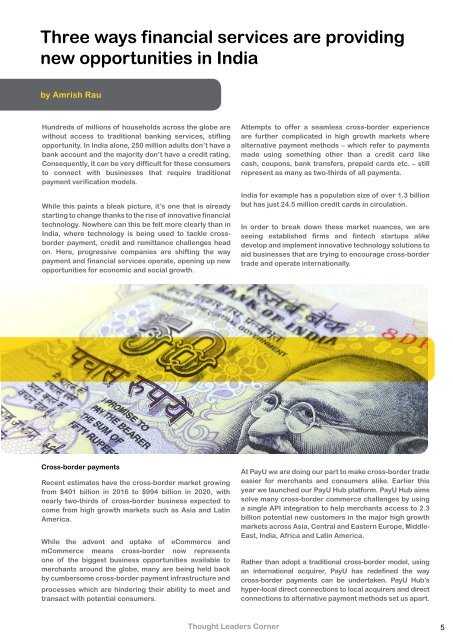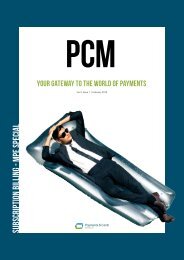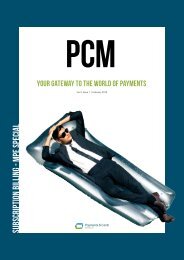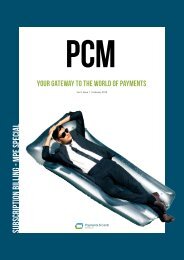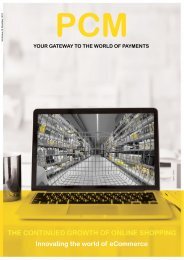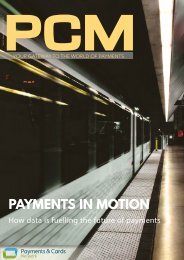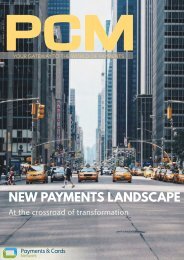PCM Vol.3 Issue 11
Emerging Markets have achieved a certain reputation in the payment industry. In this issue, we will explore the development of Emerging Markets and what's to come in terms of Payments & Financial Inclusion for the underserved
Emerging Markets have achieved a certain reputation in the payment industry. In this issue, we will explore the development of Emerging Markets and what's to come in terms of Payments & Financial Inclusion for the underserved
You also want an ePaper? Increase the reach of your titles
YUMPU automatically turns print PDFs into web optimized ePapers that Google loves.
Three ways financial services are providing<br />
new opportunities in India<br />
by Amrish Rau<br />
Hundreds of millions of households across the globe are<br />
without access to traditional banking services, stifling<br />
opportunity. In India alone, 250 million adults don’t have a<br />
bank account and the majority don’t have a credit rating.<br />
Consequently, it can be very difficult for these consumers<br />
to connect with businesses that require traditional<br />
payment verification models.<br />
While this paints a bleak picture, it’s one that is already<br />
starting to change thanks to the rise of innovative financial<br />
technology. Nowhere can this be felt more clearly than in<br />
India, where technology is being used to tackle crossborder<br />
payment, credit and remittance challenges head<br />
on. Here, progressive companies are shifting the way<br />
payment and financial services operate, opening up new<br />
opportunities for economic and social growth.<br />
Attempts to offer a seamless cross-border experience<br />
are further complicated in high growth markets where<br />
alternative payment methods – which refer to payments<br />
made using something other than a credit card like<br />
cash, coupons, bank transfers, prepaid cards etc. – still<br />
represent as many as two-thirds of all payments.<br />
India for example has a population size of over 1.3 billion<br />
but has just 24.5 million credit cards in circulation.<br />
In order to break down these market nuances, we are<br />
seeing established firms and fintech startups alike<br />
develop and implement innovative technology solutions to<br />
aid businesses that are trying to encourage cross-border<br />
trade and operate internationally.<br />
Cross-border payments<br />
Recent estimates have the cross-border market growing<br />
from $401 billion in 2016 to $994 billion in 2020, with<br />
nearly two-thirds of cross-border business expected to<br />
come from high growth markets such as Asia and Latin<br />
America.<br />
While the advent and uptake of eCommerce and<br />
mCommerce means cross-border now represents<br />
one of the biggest business opportunities available to<br />
merchants around the globe, many are being held back<br />
by cumbersome cross-border payment infrastructure and<br />
processes which are hindering their ability to meet and<br />
transact with potential consumers.<br />
At PayU we are doing our part to make cross-border trade<br />
easier for merchants and consumers alike. Earlier this<br />
year we launched our PayU Hub platform. PayU Hub aims<br />
solve many cross-border commerce challenges by using<br />
a single API integration to help merchants access to 2.3<br />
billion potential new customers in the major high growth<br />
markets across Asia, Central and Eastern Europe, Middle-<br />
East, India, Africa and Latin America.<br />
Rather than adopt a traditional cross-border model, using<br />
an international acquirer, PayU has redefined the way<br />
cross-border payments can be undertaken. PayU Hub’s<br />
hyper-local direct connections to local acquirers and direct<br />
connections to alternative payment methods set us apart.<br />
Thought Leaders Corner<br />
5


